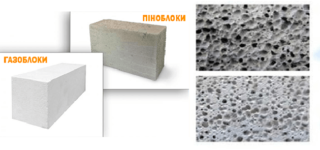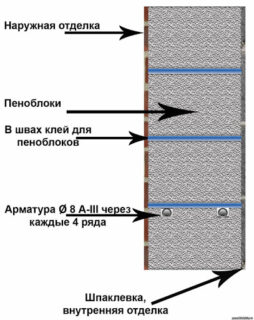The popularity of foam blocks in low-rise construction is explained by their affordable cost, low thermal conductivity and the speed of housing construction. When choosing a material, it is necessary to take into account its main technical characteristics: strength class, density, frost resistance. The purchase should be approached responsibly, there are a lot of low-quality foam concrete products on the construction market.
Foam block characteristics
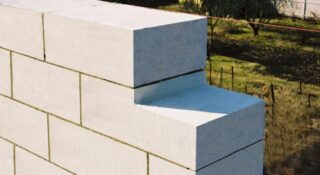
Porous building material has become popular due to its excellent thermal insulation characteristics and affordable cost. Foam concrete block is one of the types of stones made of lightweight aerated concrete. Its technical characteristics and properties are due to the peculiarities of manufacturing.
Production technology
The classic composition for foam concrete is cement, sand and water. To create a porous structure, a foam mixture is prepared separately from synthetic or organic foaming agents. When the components are mixed, air cells are formed inside the foam concrete. To save cement, ash, clay and other fine-grained materials are added to the solution. Foam blocks are obtained by hardening and curing in forms or by cutting the monolith into separate stones.
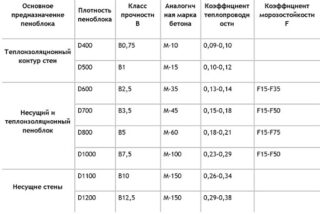
Specifications:
- Thermal conductivity coefficient - the parameter depends on the number of air cells, the more there are, the better the protection against cold. The coefficient is 0.1-0.38.
- Density - the number of pores also determines the ratio of the weight of the material to its volume. Low density reduces mass, improves insulating properties, but decreases strength.
- Frost resistance - the average indicator is 25 freeze and thaw cycles, there are brands with lower and higher frost resistance values (from 15 to 75 cycles).
- Weight - the parameter depends on the density, the smallest is 8.5 kg, the maximum is 47 kg.
The typical size of the foam block for building a house is determined by the technical conditions. The variety of sizes is small, common options are:
- 100x300x600 mm - half-block for partitions;
- 300x200x600 - for interior walls;
- 200x400x600 mm - for load-bearing walls.
The thermal conductivity of the material is calculated for dry stone. With a rise in humidity, it decreases.
Advantages and disadvantages of the material
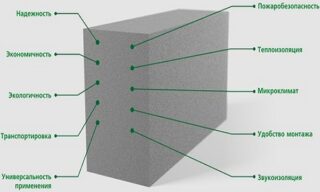
Foam blocks have many positive qualities that made it popular:
- Low thermal conductivity - in terms of energy efficiency, housing is comparable to buildings made of wood, the indicator significantly exceeds the characteristics of reinforced concrete and brick.
- Light weight - the total weight of the house allows you to arrange a light foundation, saving money on the foundation.
- Sound insulation - air pores in the stone absorb acoustic waves well.
- Fire resistance - the blocks do not burn, ensure the fire safety of the building.
- Environmental friendliness - in the composition of the material and the masonry mortar, there are safe components that do not harm health.
- Affordable cost - the building material is offered at a low price, which reduces the overall cost of building a house.
Aerated concrete is easy to process, it is easily cut, drilled, grooved. The dimensions of the blocks speed up the construction of walls and reduce labor costs.
Disadvantages:
- Natural shrinkage - the process of concrete curing is associated with shrinkage, it is 2-4 mm per linear meter.
- Uneven surface - minus is typical for a material made by molding.
- Insufficient strength - the stone is not designed for high loads, most brands are only suitable for building houses up to three floors. The porous structure causes difficulties in the reliability of fasteners.
The material has an unpresentable appearance, the blocks are gray, porous. After the construction of the building, an external cladding is required.
Comparison of the foam block with the gas block
Foam blocks dry naturally, they shrink slightly (up to 3 mm), have an uneven surface and an error in dimensions up to 5 mm. Gas blocks are distinguished by clear geometry and smooth surface. The pluses of the foam block include a lower percentage of water absorption.
Varieties of foam blocks for building a house
Products are produced with various densities ranging from 300 to 1200. This characteristic determines the thermal insulation and strength properties of the blocks. There are the following brands of building materials:
- heat-insulating - D300-D500, weight 11-19 kg, used for insulation of internal non-bearing structures;
- structural and heat-insulating - D600-D900, weight 23-35 kg, suitable for the construction of houses with one or two floors;
- structural - D1000-D1200, weight 39-47 kg, has the highest thermal conductivity (0.36-0.4 W / m * K), used for laying load-bearing walls, foundations and plinths.
By manufacturing:
- cut - the raw mass is cut with metal strings, the product has clear dimensions;
- molding - made in molds with partitions, less durable but cheap material;
- reinforced - polymer or basalt fiber, fiberglass (up to 1% of the volume) are added to the composition, enhancing the strength characteristics of the blocks.
By appointment:
- wall - the most durable products for the construction of external enclosing structures;
- partition wall - small block 100x300x600 mm;
- non-standard - products are manufactured according to customer requirements.
Making building materials at home has become a common practice. The simplicity of production technology and the availability of equipment allow you to create a profitable business. When buying foam concrete, you should check the quality certificates for the product.
Selection rules
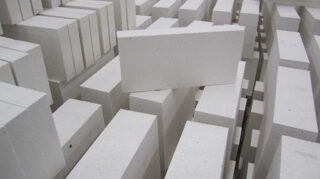
If a porous artificial stone is chosen as a material for the walls in the project of the house, then you should decide on its purpose. For load-bearing walls, large-sized products of high and medium density D600-D1200 are used. Partitions and unloaded structures can be erected from a material of lower density, it will cost less.
Choosing which foam block is better to build a private house from, evaluate its external parameters:
- uniformity of the structure, uniform distribution of pores (checked in section);
- size and weight - the unit can be measured and weighed to find out if it meets the stated figures;
- uniformity of color, light shade indicates the low quality of the product;
- there should be no cracks or chips on the stones.
When buying, they pay attention to the frost resistance of the blocks, if the construction takes place in a warm region, then the average is sufficient. Housing in cold areas requires material with a 50-75 cycle rate. The low cost of products attracts buyers, but it can mean a violation of technology and the use of poor quality raw materials.You also need to find out the time of production of a batch of blocks, They must lie for at least a month to gain strength.
The process of working with a foam block
The stone is laid on a cement-sand mortar. The use of adhesive mixtures reduces heat loss, but due to the uneven surface of the blocks, their use is not recommended. Another difficulty is the insufficient strength of the fasteners. Use dowels and anchors designed for porous concrete.
When erecting a building, it is necessary to provide for reinforcement. The laying of metal bars is carried out, starting from the first row, every four. It is also laid in window and door openings. In the blocks, grooves are sawn for reinforcement, which are filled with glue solution. It is possible to use a plastic or metal mesh, in this case it is not necessary to cut the blocks. Reinforcement will prevent the walls from cracking during shrinkage.
Hygroscopic aerated concrete accumulates moisture, therefore, after the construction of housing, external finishing is necessary. A suitable option is plastering followed by painting, installation of siding, cladding with artificial stone. Finishing starts 3-4 months after the house is built. It takes time to shrink.
A house made of foam concrete blocks is built in a short time, it turns out to be warm and durable. The porous material provides a favorable microclimate, protects against street noise. When deciding which foam block to choose for building your home, it is important not to save on strength and contact a trusted manufacturer.

